

Alice Meets Virginia
I thought myself lucky to have met Alice Neel at all. I admired her early paintings that combined expressionist and surrealist modes to expose her pain.
|
|
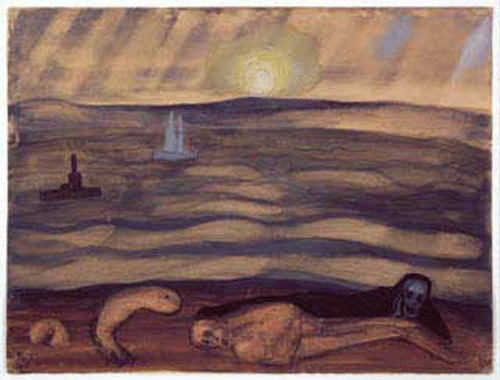 Alice Neel: Requiem (1928) |
I felt myself to be luckier still to have spent a week with her in St. Louis in 1975. It was my job to escort her around to colleges and museums where she gave critiques and lectures. I tried to act casual about the importance of my job of taking care of a visiting artist, but I was secretly full of the wrong kind of pride.
The possibility that I might become friends with a woman like her, an accomplished artist who was gaining fame, excited me. The Whitney Museum of American Art had given her a retrospective in 1974.
As soon as I moved to New York in the fall of 1977, I telephoned her. She lived on 107th and Broadway on the Upper West Side near my sister’s apartment where I stayed often, so it was easy to visit with her.
Alice Neel had a pretty face, strawberry blond hair, and a body with feminine curves. In her prime, men must have desired her while women envied her. Alice’s well-proportioned features were not at all striking or extraordinary, but they held up well over time. When she was 75 years old her face was still pretty. She looked like a sweet grandmother.
I have at times wondered if her good looks caused her calamitous life, but I suspect that it was her background coupled with her formidable ambition that drove her to a private life of hardship and a successful public life.
She easily admitted her lower middle class origins, “My father worked for the Pennsylvania Railroad,” she said, “while Mary Cassatt’s father owned the railroad.” Actually, it was Mary Cassatt’s brother, A. J. Cassatt who was the seventh president of PPR, from 1899 to 1906, but Mary Cassatt was definitely upper-middle-class.
Alice’s political sympathies were with the poor. Pro-communist early on, she favored and supported liberal ideas and social reform throughout her life.
Her apartment, like so many Upper West Side homes similar to my sister’s place, was designed for families. Floor plans by excellent architects still provide well-proportioned rooms accessed through the hallways, elegantly separating the functions of a home: cooking, eating, sleeping, bathing, studying and socializing. Some apartments even have a maid’s room with a half-bath and two front doors with separate entrances, a small hallway for the maid and a grand foyer for the family.
In Alice’s apartment there was a painting in progress mounted on an easel in almost every room, and she had painted a mural in the kitchen where the old plaster wall had deteriorated. Her way of life is what I liked most about her at that time. It was what I needed to see and to connect with in order to believe that I could be an artist too.
As I began to spend time with Alice, red flags appeared, floating by, hovering around, and sometimes flying right in my face. I didn’t want to see them.
I was visiting her one beautiful October day. I caught sight of a yellow-orange gingko tree from her living room window shimmering in the park outside. All of its leaves were still on its branches.
In autumn a gingko tree drops its leaves in a short period of time, sometimes dropping them all in one day. Gingko biloba, a living fossil, is the only extant species in an ancient line. It prefers to grow in disturbed sites like rocky slopes and cliff edges. It can adapt to what a human might call hardships. Each tree is either male or female, but it can clone itself if there are no members of the opposite sex nearby.
I heard a psychiatrist once say that a human can shed masochism all of a sudden like a cloak dropping to the ground, and, I suppose, like a gingko on a rocky slope shedding its leaves all at once. Gingko biloba could be claimed to be the tree of masochists.
I was so startled by the gingko’s beauty that I called out, “Alice, come and see the tree outside, its color!”
She walked over and stood by my side. She hissed, “You will never paint that tree from this window.” She emphasized the word “never.”
Once she was describing how difficult her life as an artist had been, how poor she was, how abused by boyfriends and husbands. She looked right into my eyes, and said, “You will never be a great artist,” this time she put the emphasis on “you.”
She explained, continuing to emphasize “you.” “Why, you don’t have enough courage to shoplift. You couldn’t steal even if your children were hungry.”
Despite the red flags, I wanted Alice to meet Virginia Admiral. I had recently met Virginia, and she and I had just begun to draw and paint together almost daily in her downtown loft on the corner of Spring and Lafayette.
Fifteen years after her death at the age of 85, I find myself remembering Virginia Admiral often. I recently saw a reproduction of a painting she did in 1944, “The Red Table,” which I had never seen before. Now as soon as I think of Virginia, that painting pops into my mind.
“The Red Table” is Virginia at her best. Reading it left to right, one encounters two bold X’s askew. Next, the word VALDANO is written on a bottle within a clear bottle within a yellow circle,
A black vertical line, not quite plumb, dominates the composition, pointing up like a candlestick. In front of it floats an opaque blue form that could be a candlestick holder, suspended and tantalizing, seeming to say, “Come and get me,‘ to the candlestick. A kidney-shaped form adds to the mystery.
The colors are jarring: stark white, scarlet red, screaming teal and five shades of yellow from pale lemon to cadmium yellow deep. Three different types of stripes are scattered around the periphery in small, medium, and large areas.
Small logos and objects are insecurely attached, unsettled in the tilting open spaces. A little black flag or axe floats above an organic red shape that could be a boat. The red shape establishes the only horizontal in the painting, offering some stability to the image.
The painting seems to have been conceived by raw nerve alone and executed in a state of aggression. It causes a disturbance that is not mitigated by a few feminine Matisse-like flourishes.
“The Red Table” was exhibited in New York in 1946, was praised profusely, and then forgotten.
I can see the teachings of Virginia’s teacher, Hans Hofmann, in the distorted planes of its composition, but here Virginia has done Hofmann better than Hofmann did Hofmann.
Hofmann himself clearly recognized Virginia’s accomplishments. Once while critiquing his students, he stopped in front of Virginia’s work and said, “This is pure genius.”
While Hofmann was essentially an engineer who chose to be an artist and adapted his skills to accommodate modernism by distorting the picture plane in line with Cezanne’s practices, Virginia was an artist whose life was so deconstructed so very early on that distorted planes were what she felt comfortable with and maybe even thrived on. Hofmann simply provided her with the means to express herself.
|
|
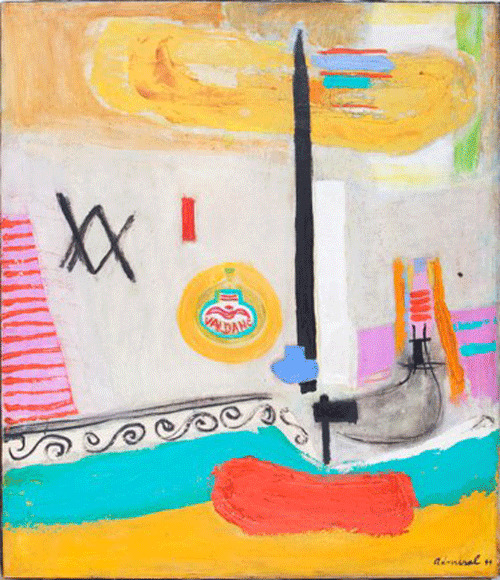 Virginia Admiral: The Red Table (oil on canvas, 1944) Collection Anne and Robert Bertholt |
Virginia’s mother, a school teacher, had bouts of schizophrenia. The family moved West from the Midwest in hopes that her father would do well, but he didn’t. Virginia, the older of two girls, was her father’s favorite. He abandoned the family when she was a teenager, and her mother was committed to the insane asylum a few years later, never getting out.
As a young child, Virginia made it clear that she did not want to be a “good girl.” Her cousin tells the story of her as a little girl playing in the rain after a family outing. She jumps out of the car and splashes in the mud calling out “I’ve been good long enough. I can’t be good any longer,” splattering herself, her white shoes and her frilly dress with mud.
Throughout her adult life Virginia had at least two close girlfriends all the time, one “good” girl and one “bad” girl. Shortly after she met me she chose me to be the “good” girl. By the time I caught on to her madness, it was too late. I was thoroughly attached to her.
Occasionally Virginia and I walked a few blocks up Lafayette Street to the Public Theatre or to a theatre in the Village to watch movies, sometimes to see her son Robert de Niro in a rerun. In theatres someone had to sit next to her because she had narcolepsy and needed to be prodded to stay awake every now and then especially if there were a good scene coming up.
Cataplexy accompanied Virginia’s narcolepsy, causing her body to collapse suddenly when she laughed or felt a strong emotion. Her loss of voluntary muscle tone exposed the intensity of her thoughts and feelings. After a while the graphic honesty of the catalepsy became an endearing and entertaining feature in any exchange with her.
Bang The Drum Slowly (1973) ostensibly a sports film about baseball, was one of Virginia’s favorites because of a scene that had nothing to do with baseball. In it six team members form a line and sing and dance for a local TV show. They are dressed in street wear of the era, flashy jackets and slacks.
|
|
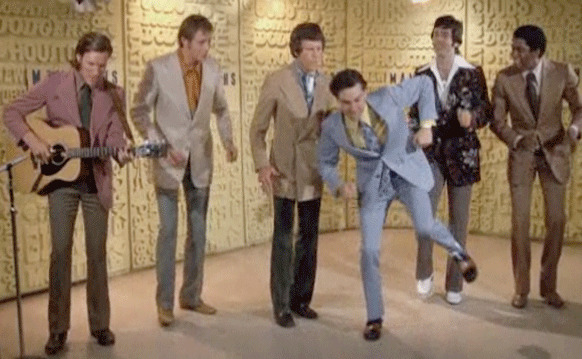 Screen shot from Bang the Drum Slowly' |
They dance forward and back for a while and then de Niro, playing the team’s not-so-smart catcher from the South, breaks into a spontaneous and slightly awkward little jig. Virginia got the point of the movie, male bonding, and was happy to see her son as one of the guys.
I introduced Alice Neel to Virginia Admiral one autumn Sunday afternoon in 1977. Dorothy Gillespie picked Alice and me up from 107th Street and drove us downtown in her car to a gallery event. Gillespie was well known then. She had worked with her husband running a café until her children grew up, and then she joined the feminist movement and devoted her life to painting and sculpture.
A large abstract mural that Gillepsie created on the southwest corner of Houston and Mercer has been painted over since, but at that time and for many years after it was one of a number of murals and wall pieces that functioned as landmarks, separating the territory south of Houston from the rest of the city, proclaiming it sacred ground for new ideas, new performances, new styles, new media and new ways to live and create.
The plan was to attend a gallery event and then drop by Virginia’s loft on Spring and Lafayette. The event was uneventful except for an older woman who chased a young man around for a long time trying to get his attention. She finally grabbed his thigh, sat on the floor and hung on to him so he couldn’t get away from her. No one paid any attention to her.
Having recently arrived from St. Louis where no one in the art world behaved like that in public, I was dismayed and embarrassed. Back home anyone making a fool of herself would have been stopped and brought back down to earth.
When we arrived at Virginia’s loft I gave Dorothy and Alice a tour showing first the bedrooms that were walled off on the west side, and then the bathroom which Virginia had decorated with mosaics and colorful paint.
The rest of the high-ceilinged space was spectacularly lit by twelve tall windows, three facing north, one at an angle turning the corner to face northeast, and eight facing east.
|
|
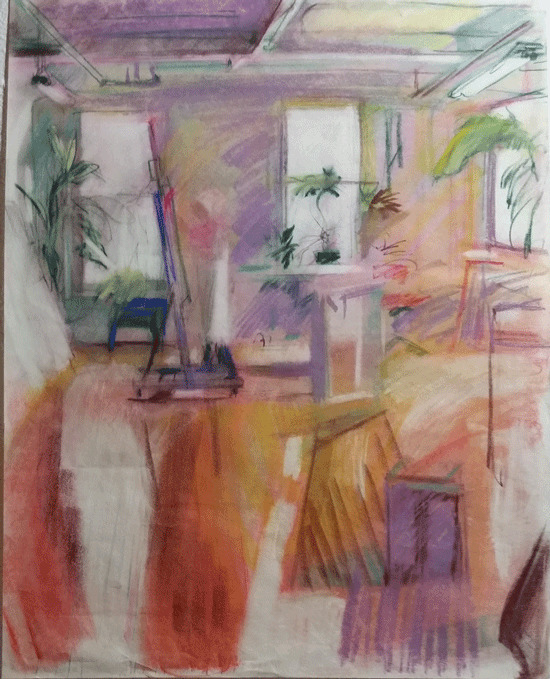 Minerva Durham, Virginia Admiral’s third floor loft at 226 Lafayette, 1978, 24in x 19in, pastel on paper, Collection of Kenneth Koen |
Daylight entered and stayed, feeding the plants and bouncing back up from the glossy floors that Virginia had sanded and sealed with polyurethane all by herself as soon as she had moved in. Plants pressed on the windowpanes that faced east. One aloe plant had leaves as thick as elbows at its base.
Pieces of furniture, left over from Virginia’s recently-closed typesetting and printing business, Academy Typesetting — massive oak desks, low bookshelves and rolling oak office chairs — were strategically placed. They divided the loft into a large working studio near the windows, a smaller social space with facing couches and chairs, and a dining area near the narrow galley-style kitchen near the entrance..
There were single-edged razor blades on nearly every surface in the loft. Virginia’s typesetting business had thrived during the cut-and-paste era, and she needed to know that blades were always handy.
Above were tin ceilings, the sprinkler system, rows of pipes, and long fluorescent light fixtures that were seldom turned on. The available wall space displayed canvases, large geometric images that Virginia had painted during the twenty years that she ran her business.
|
|
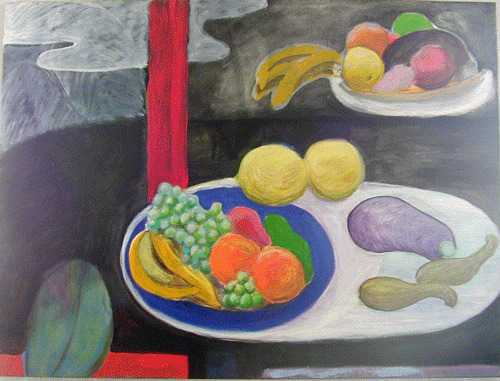 Virginia Admiral: Still Life (date unknown, oil on canvas) |
Virginia and I spent our days working together from nude models, street scenes, still lifes or plants. My favorite spot to work was near the window facing northeast. I had set up an easel and a still life there.
Alice stopped briefly in front of the easel and studied my half-finished drawing of a bottle, cloth, and some fresh fruit, and said, “Oh, dear, Minerva, your drawing is so ordinary,” emphasizing the word “ordinary.”
Then I served coffee and tea as the four of us, Alice, Dorothy, Virginia and I, settled down on the couches in the social space.
I can’t remember even a fragment of the conversation. There we were, four women with a total of twelve live births between us, each one of us powerful in her own way, all four of us committed to art and feminism, and, in my recollection, we had nothing memorable or of importance to say to each other.
As soon as Alice and Dorothy left, Virginia and I carried the cups and saucers to the kitchen and loaded the dishwasher. Virginia had something to say. She leaned on the sink holding her body up with both hands.
”Your friend, Alice Neel,” she began, but she paused, grimaced, and began to go limp. Her head bent down and her arms and legs were folding up in cataplexy. With great effort she straightened herself up and began again, ”Alice Neel . . . is the . . . most . . . nar . . . cis . . . sis . . . tic . . . person . . . I have ever met.”
The next afternoon, Uptown, I called Alice from my sister’s wall phone, a land line that was hung at shoulder height in the kitchen. No one had personal cell phones then.
I greeted Alice and she immediately said, “That woman is so homely,” with the emphasis on “homely.”
I stiffened. I tried to avoid a disaster. I asked Alice, “Do you mean the older woman who grabbed the young man’s thigh at the gallery? She was pretty ugly.”
“No,” Alice said, “I mean your friend Virginia, the mother of the actor. Why, she is the homeliest person I have ever met.”
I stiffened again and I turned into a gingko tree. My leaves were ripe and brilliant yellow-orange and I shed every single one of them in one second. I politely ended the conversation with Alice, and I never saw or spoke with her again.
Just like that, I chose Downtown over Uptown, community over self, and anarchy over tyranny.
I chose freedom and possibilities and love and connectedness over anything that might ever oppress those qualities. In short, I chose Virginia over Alice.


copyright © 2015 Minerva Durham
 index
index